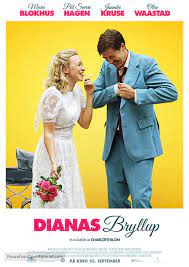
DIANA’S WEDDING/ DIANAS BRYLLUP
Norway, 2020, 86 minutes, Colour.
Marie Blokhus, Pal Sverre Hagen, Jannike Cruz, Olav Waastad. Ine Marie Wilmann, John emil Jorgensrud.
Directed by Charlotte Blom.
For many audiences who are not as young as they used to be, the title Diana’s Wedding would immediately bring to mind the 1981 Westminster Abbey ceremony where Diana Spencer married Prince Charles. Not sure whether Diana’s Wedding means very much to those under 40 since it is 40 years since that wedding. However, it is this wedding that is the point of reference for this comedy/drama about marriage.
The film opens in 1981, an exuberantly happy atmosphere as Live and Terge are married. The wedding is important for them when they name all their daughter, born 1981, Diana. Actually, as the film progresses, there are continued references to Diana and Prince Charles, happiness leading into unhappiness, Charles’s behaviour with Camilla, the separation, Diana and Dodi Al Fayed, and expressions of great grief at the news of her death.
It would be interesting to hear the Royal family’s response to the use of the wedding for this film, for British reactions. (Perhaps displeasure.) However, for the rest of the world, and in Europe, and throughout the Commonwealth, there are many mixed feelings about Diana and Charles.
But, of course, the focus is on Liv and Terje, the birth of their daughter, the young son, Cato. Liv and Terje tend to be a very happy-go-lucky couple, he at work with his mates, she at home with verve, at a holiday camp where the little Diana actually follows her father as he goes with the blokes to a strip club – and later draws photos of the pole-dancers to her mother’s dismay and anger against her husband. So, this is what marriages are like! Love, sometimes over the top, huge mistakes, eventual forgiveness, love again.
But this is by contrast with the couple across the street, Olav and Unni, welcoming the newcomers, revealing a contrasting marriage, he rather self-contained, concerned about his health, sometimes with a roving eye, she also a touch prim but gradually, with her drinking, loosening up – and even more loosening up. They have a daughter, Irene, and Diana and Irene are the best of friends.
Then, shock. It is 2020. Diana and Irene are still friends. It was big, bearded, burly, and a genial mediator in the family as well as the disc jockey. Diana is about to be married. And what about the couples? Liv age and Terge are just the same but the often-embarrassed and angry Diana doesn’t really want them at her wedding. Olav and Unni are much the same except that he is still self-preoccupied and Unni has become more desperately unhappy, taking it out on Irene and criticising her figure and weight.
Any resolution? You will have to see. However, the film’s overall tone is less like the unhappy marriage of Charles and Diana but the belief that, no matter what the ups and downs, no matter what the squabbles and tantrums, the underlying love is most important.
- The title? The reference to the wedding between Charles and Diana? The continued points of reference throughout their marriage, the failure of the marriage, Diana’s death?
- Audience response to the Diana references, British perspectives, European perspectives, worldwide perspectives?
- The opening in 1981, Liv and Terge, engaged, the wedding, in love? Pregnancy? The birth of Diana and its effect? Cato as the young son? The progress of the marriage, ups and downs? Terge, his work, manual, his friends, drinking, celebrations? The moods between them? Liv at home? The holiday, the children playing, Diana following her father, the strip club, her later drawings, the revelation, the clash between husband and wife? This Is a pattern for their lives, moods, Terge having to move out, coming home, reconciliations?
- The neighbours, watching the couple arrive, the friendly welcoming, the visits to the homes, the two girls playing together, Cato in the girl’s clothes? The ups and downs of Unni and Olav’s marriage? Rather proper, Olav and his work, observing, the touch of a roving eye, concerned about his weight and health? Passive? The approach to Liv? The contrast with Unni, drinking, coming out of her self, the years and the relationship with Olav?
- The two girls, their friendship?
- Suddenly in 2020, the girls grown up, their continued friendship? Diana, her engagement, not wanting her parents to come to the celebration, her fiance?
- Liv and Terge in 2020, still together, the car breaking down, their still fighting? Their arrival, Diana rejecting them? Their leaving? The decision to come back? Cato, big and bearded, his interventions?
- Unni and Olav, their coming, the tension between them, Olav in his self preoccupation, Unni older, their drifting apart, her criticisms of her daughter, Irene’s reactions? The relationship coming to a head, Unni and the advice, the decision to leave Olav, telling him of the divorce?
- Diana and the prospect of her wedding, not being like her parents? Yet the reflection on them that they had stayed together, the ups and downs, fights, tantrums, exuberant behaviour, but, all the while, for loving each other?
- A reflection on contemporary marriage relationships? Surface aspects? Deeper love?